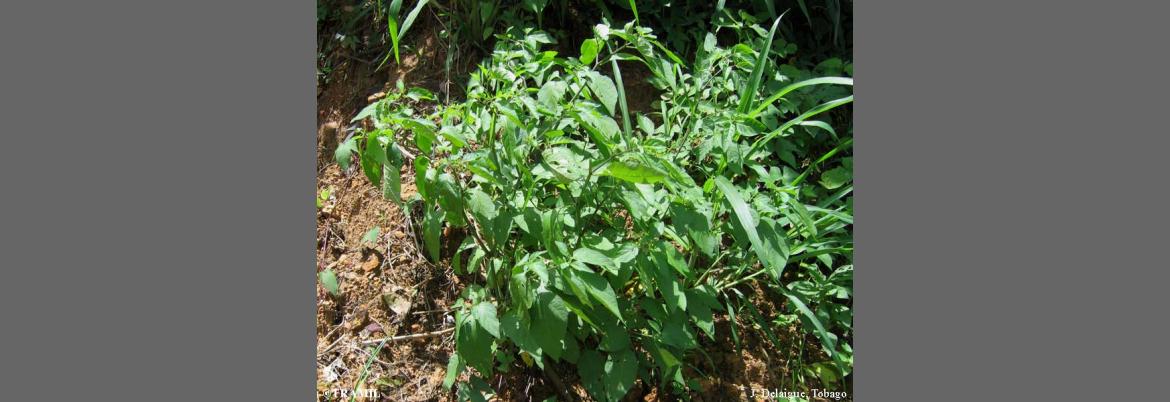1 GIRON L,1988 Encuesta TRAMIL (Costa atlántica). Centro Mesoamericano de Tecnología CEMAT, Guatemala, Guatemala.
2 DELENS M, 1990 Encuesta TRAMIL en Barlovento, Edo. Miranda de Venezuela. Centro al Servicio de la Acción Popular CESAP, Caracas, Venezuela.
3 GOMEZ H, 2003 Estudio fitoquímico de algunas plantas promisorias del Caribe colombiano. Informe TRAMIL. Grupo de Productos Naturales, Facultad de Ciencias Químicas y Farmacéuticas. Universidad de Cartagena, Cartagena de Indias, Colombia.
4 ALDANA MV, LIMA CN, 1999 Isolation and characterization of a glycoside from fluid extracts of Solanum americanum Mill. Afinidad 56(484):393-396.
5 CACERES A, ALVAREZ AV, OVANDO AE, SAMAYOA B, 1991 Plants used in Guatemala for the treatment of respiratory diseases. 1. Screening of 68 plants against Gram-positive bacteria. J Ethnopharmacol 31(2):193-208.
6 VICTORIA AE, 1980 Investigación farmacológica de la acción hipoglucemiante de la hoja de Solanum nigrescens Mart & Gal. (macuy, quilete o hierba mora). Tesis Guatemala, Facultad de CCUU y Farmacia, USAC, Guatemala, Guatemala.
7 COONEY G, BUCKLEY H, BRICKUS T, CACERES A, 1991 Fungicidal activity of Solanum plant extract from Guatemala, C.A. Abstracts CD52. Pharmacy Word Cong, Washington DC, USA.
8 CACERES A, LOPEZ BR, GIRON MA, LOGEMANN H, 1991 Plants used in Guatemala for the treatment of dermatophytic infections. 1. Screening for antimycotic activity of 44 plant extracts. J Ethnopharmacol 31(3):263-276.
9 CACERES A, 2000 Plantas antimicrobianas de Mesoamérica. 1er Congreso Peruano de Plantas Medicinales y Fitoterapia, Lima: 41-44.
10 ADESINA SK, 1982 Studies on some plants used as anticonvulsants in Amerindian and African traditional medicine. Fitoterapia 53:147-162.
11 SANCHEZ LM, BULNES C, PEREZ P, RODRIGUEZ A, NOA M, GINORIO C, GOMEZ BC, 2003 Actividad antibacteriana, cicatrizante y útero-estimulante de Solanum americanum Miller. Actualidades Biológicas 25(78): 71-78.
12 ALTSCHUL S, 1973 Drugs and food from little-known plants: Notes in Harvard University Herbaria. Cambridge, USA: Harvard Univ Press.
13 MORTON J, 1977 Some folk-remedy plants of Central American markets. Quart J Crude Drug Res 15:165-192.
14 SOUZA-NOVELO N, 1950 Plantas alimenticias y plantas de condimento que viven en Yucatán. Mérida, México: Inst.Tecn.Agrícola Henequenero.
15 ALBORNOZ A, 1993 Medicina Tradicional Herbaria. Caracas Venezuela: Editorial Instituto Farmacoterápico Latino S.A. p132.
16 CACERES A, 1996 Plantas de uso medicinal en Guatemala.Ciudad de Guatemala, Guatemala: Editorial Universitaria. p315.
17 LOPEZ M, MARTINEZ MJ, MOREJON Z, BOUCOURT E, FERRADA C, FUENTES V, MORON F, 2005 Irritabilidad dérmica primaria de una decocción de hoja seca Solanum americanum Mill. Informe TRAMIL. Laboratorio Central de Farmacología, Facultad de Medicina “Dr. Salvador Allende”, Cerro, C. Habana, Cuba.
18 MARTINEZ MJ, LOPEZ M, MOREJON Z, BOUCOURT E,FUENTES V, MORON F, 2005 Irritabilidad vaginal de decocción de hoja seca de Solanum americanum. Informe TRAMIL. Laboratorio Central de Farmacología, Facultad de Ciencias Médicas “Dr. Salvador Allende”, La Habana, Cuba.
19 MARTINEZ MJ, LOPEZ M, MOREJON Z, BOUCOURT E,FUENTES V, MORON F, 2005 Clases tóxicas agudas oral de decocción de hoja seca, de tallo seco y de frutos verdes secos de Solanum americanum. Informe TRAMIL. Laboratorio Central de Farmacología, Facultad de Ciencias Médicas "Dr. Salvador Allende", La Habana, Cuba.
20 PAZOS L, COTO T, CAIZA F, 2009
Irritación dérmica, piel sana en conejos, porción de hoja fresca de Solanum americanum. Informe TRAMIL. Laboratorio de Ensayos Biológicos, LEBi, Universidad de Costa Rica, San Pedro, Costa Rica.


















